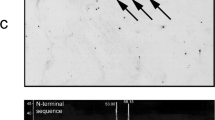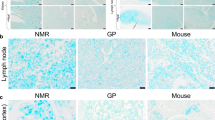Abstract
Arylsulfatase A (ARSA) and B (ARSB) have been regarded as lysosomal enzymes because of their hydrolytic activity on synthetic aromatic substrates and the lysosomal localization of their enzymatic activity. Using sea urchin embryos, we previously demonstrated that the bulk of ARS is located on the cell surface of the epithelium, colocalizing with sulfated polysaccharides, and that it does not exhibit enzymatic activity. To examine whether ARSA and ARSB exist on the cell surface in mammalian tissues, we raised antibodies against ARSA and ARSB and examined immunohistochemically their localization in the liver using light and electron microscopy. Here we show that mammalian ARSA and ARSB exist on the cell surface of sinusoidal endothelial cells, hepatocytes, and sinusoidal macrophages (Kupffer cells), as well as in the lysosome. They are also colocalized with heparan sulfate proteoglycan. These results suggest that ARSA and ARSB also may function in the cell surface of mammals. This is the first report to show cell-surface localization of ARS in mammalian somatic cells. The extracellular localization of ARS will provide new insight for human ARS deficiency disorders, such as metachromatic leukodystrophy and mucopolysaccharidosis VI.
Similar content being viewed by others
References
Sardiello M, Annunziata I, Roma G, Ballabio A (2005) Sulfatases and sulfatase modifying factors: an exclusive and promiscuous relationship. Hum Mol Genet 14:3203–3217
Obaya AJ (2006) Molecular cloning and initial characterization of three novel human sulfatases. Gene 372:110–117
Diez-Roux G, Ballabio A (2005) Sulfatases and human disease. Annu Rev Genomics Hum Genet 6:355–379
Gieselmann V, Matzner U, Hess B, Lüllmann-Rauch R, Coenen R, Hartmann D, D’Hooge R, DeDeyn P, Nagels G (1998) Metachromatic leukodystrophy: molecular genetics and an animal model. J Inherit Metab Dis 21:564–574
Gieselmann V (2003) Metachromatic leukodystrophy: recent research developments. J Child Neurol 18:591–595
Yogalingam G, Litjens T, Bielicki J, Crawley AC, Muller V, Anson DS, Hopwood JJ (1996) Feline mucopolysaccharidosis type VI. Characterization of recombinant N-acetylgalactosamine 4-sulfatase and identification of a mutation causing the disease. J Biol Chem 271:27259–27265
Neufeld EF, Muenzer J (2001) The mucopolysaccharidoses. In: Scriver CR, Beaudet AL, Sly WS, Valle D (eds) The metabolic and molecular bases of inherited disease, 8th edn. McGraw-Hill, New York, pp 3421–3452
Litjens T, Hopwood JJ (2001) Mucopolysaccharidosis type VI: structural and clinical implications of mutations in N-acetylgalactosamine-4-sulfatase. Hum Mutat 18:282–295
Koppe JG, Marinkovic-Ilsen A, Rijken Y, De Groot WP, Jöbsis AC (1978) X-linked ichthyosis: a sulphatase deficiency. Arch Dis Child 53:803–806
Hopsu-Havu VK, Arstila AU, Helminen HJ, Kalino HÖ (1967) Improvements in the method for the electron microscopic localization of arylsulfatase activity. Histochemie 8:54–64
Seljelid R, Helminen HJ (1968) The localization of aryl sulfatase activity in thyroid follicle cells. J Histochem Cytochem 16:467–472
Kawano J, Aikawa E (1987) Ultrastructural localization of arylsulfatase C activity in rat kidney. J Histochem Cytochem 35:523–530
Jöbsis AC, De Groot WP, Tigges AJ, De Bruijn HW, Rijken Y, Meijer AE, Marinkovic-Ilsen A (1980) X-linked ichthyosis and Xlinked placental sulfatase deficiency: a disease entity. Histochemical observations. Am J Pathol 99:279–289
Daniele A, Parenti G, d’Addio M, Andria G, Ballabio A, Meroni G (1998) Biochemical characterization of arylsulfatase E and functional analysis of mutations found in patients with X-linked chondrodysplasia punctata. Am J Hum Genet 62:562–572
Hanson SR, Best MD, Wong CH (2004) Sulfatases: structure, mechanism, biological activity, inhibition, and synthetic utility. Angew Chem Int Ed Eng 43:5736–5763
Frese M-A, Schulz S, Dierks T (2008) Arylsulfatase G, a novel lysosomal sulfatase. J Biol Chem 283:11388–11395
Mitsunaga-Nakatsubo K, Akasaka K, Akimoto Y, Akiba E, Kitajima T, Tomita M, Hirano H, Shimada H (1998) Arylsulfatase exists as non-enzymatic cell surface protein in sea urchin embryos. J Exp Zool 280:220–230
Peters C, Schmidt B, Rommerskirch W, Rupp K, Zühlsdorf M, Vingron M, Meyer HE, Pohlmann R, von Figura K (1990) Phylogenetic conservation of arylsulfatases. cDNA cloning and expression of human arylsulfatase B. J Biol Chem 265:3374–3381
Akimoto Y, Yamakawa N, Furukawa K, Kimata K, Kawakami H, Hirano H (2002) Changes in distribution of the long form of type XII collagen during chicken corneal development. J Histochem Cytochem 50:851–862
Bond CS, Clements PR, Ashby SJ, Collyer CA, Harrop SJ, Hopwood JJ, Guss JM (1997) Structure of a human lysosomal sulfatase. Structure 5:277–289
Evers M, Saftig P, Schmidt P, Hafner A, McLoghlin DB, Schmahl W, Hess B, von Figura K, Peters C (1996) Targeted disruption of the arylsulfatase B gene results in mice resembling the phenotype of mucopolysaccharidosis VI. Proc Natl Acad Sci USA 93:8214–8219
Stein C, Gieselmann V, Kreysing J, Schmidt B, Pohlmann R, Waheed A, Meyer HE, O’Brien JS, von Figura K (1989) Cloning and expression of human arylsulfatase A. J Biol Chem 264:1252–1259
Ngernosoungnern A, Weerachatyanukul W, Saewu A, Thitilertdecha S, Sobhon P, Sretarugsa P (2004) Rat sperm AS-A: subcellular localization in testis and epididymis and surface distribution in epididymal sperm. Cell Tissue Res 318:353–363
Wu A, Anupriwan A, Iamsaard S, Chakrabandhu K, Santos DC, Rupar T, Tsang BK, Carmona E, Tanphaichitr N (2007) Sperm surface arylsulfatase A can disperse the cumulus matrix of cumulus oocyte complexes. J Cell Physiol 213:201–211
Sasaki H, Akasaka K, Shimada H, Shiroya T (1987) Purification and characterization of arylsulfatase from sea urchin embryo. Comp Biochem Biophys 88B:147–152
Ghosh D (2007) Human sulfatases: a structural perspective to catalysis. Cell Mol Life Sci 64:2013–2022
Kawano J, Kotani T, Umeki K, Oinuma T, Ohtaki S, Aikawa E (1989) A monoclonal antibody to rat liver arylsulfatase C and its application in immunohistochemistry. J Histochem Cytochem 37:683–690
Mehl E, Jatzkewitz H (1968) Cerebroside 3-sulfate as a physiological substrate of arylsulfatase A. Biochim Biophys Acta 151:619–627
Yogalingam G, Litjens T, Bielicki J, Crawley AC, Muller V, Anson DS, Hopwood JJ (1996) Feline mucopolysaccharidosis type VI. Characterization of recombinant N-acetylgalactosamine 4-sulfatase and identification of a mutation causing the disease. J Biol Chem 271:27259–27265
Dhoot GK, Gustafsson MK, Ai X, Sun W, Standiford DM, Emerson CP Jr (2001) Regulation of Wnt signaling and embryo patterning by an extracellular sulfatase. Science 293:1663–1666
Morimoto-Tomita M, Uchimura K, Werb Z, Hemmerich S, Rosen SD (2002) Cloning and characterization of two extracellular heparin-degrading endosulfatases in mice and humans. J Biol Chem 277:49175–49185
Sasaki H, Yamada K, Akasaka K, Kawasaki H, Suzuki K, Saito A, Sato M, Shimada, H (1988) cDNA cloning, nucleotide sequence and expression of the gene for arylsulfatase in the sea urchin (Hemicentrotus pulcherrimus) embryo. Eur J Biochem 177:9–13
Rapraeger AC, Epel D (1981) The appearance of an extracellular arylsulfatase during morphogenesis of the sea urchin Strongylocentrotus purpuratus. Dev Biol 88:269–278
Akasaka K, Terayama H (1983) Sulfated glycan present in the EDTA extract of Hemicentrotus embryos (mid-gastrula). Exp Cell Res 146:177–185
Akasaka K, Terayama H (1984) A proteoglycan fraction isolated from the EDTA extract of sea urchin (Hemicentrotus pulcherrimus) gastrulae stimulates reaggregation of dissociated embryonic cells. Exp Cell Res 150:226–233
Akasaka K, Akimoto Y, Sato M, Hirano H, Shimada H (1990) Histochemical detection of arylsulfatase activity in sea urchin embryos. Dev Growth Differ 32:293–298
Akasaka K, Uemoto H, Wilt F, Mitsunaga-Nakatsubo K, Shimada H (1997) Oral-aboral ectoderm differentiation of sea urchin embryos is disrupted in response to calcium ionophore. Dev Growth Differ 39:373–379
Haag ES, Raff RA (1998) Isolation and characterization of three mRNAs enriched in embryos of the direct-developing sea urchin Heliocidaris erythrogramma: evolution of larval ectoderm. Dev Genes Evol 208:188–204
Steckel F, Hasilik A, von Figura K (1983) Biosynthesis and maturation of arylsulfatase B in normal and mutant cultured human fibroblasts. J Biol Chem 258:14322–14326
Sommerlade HJ, Selmer T, Ingendoh A, Gieselmann V, von Figura K, Neifer K, Schmidt B (1994) Glycosylation and phosphorylation of arylsulfatase A. J Biol Chem 269:20977–20981
Laidler P, Litynska A (1997) Arylsulfatase A from human placenta possesses only high mannose-type glycans. Int J Biochem Cell Biol 29:475–483
Stein M, Zijderhand-Bleekemolen JE, Geuze H, Hasilik A, von Figura K (1987) Mr 46,000 mannose 6-phosphate specific receptor: its role in targeting of lysosomal enzymes. EMBO J 6:2677–2681
Chao HH, Waheed A, Pohlmann R, Hille A, von Figura K (1990) Mannose 6-phosphate receptor dependent secretion of lysosomal enzymes. EMBO J 9:3507–3513
Ghosh P, Dahns NM, Kornfeld S (2003) Mannose 6-phosphate receptors: new twists in the tale. Nat Rev Mol Cell Biol 4:202–212
Geuze HJ, Slot JW, Strous GJ, Hasilik A, Von Figura K (1984) Ultrastructural localization of the mannose 6-phosphate receptor in rat liver. J Cell Biol 98:2047–2054
Yoshida M, Noguchi J, Ikadai H, Takahashi M, Nagase S (1993) Arylsulfatase B-deficient mucopolysaccharidosis in rats. J Clin Invest 91:1099–1104
Yoshida M, Ikadai H, Maekawa A, Takahashi M, Nagase S (1993) Pathological characteristics of mucopolysaccharidosis VI in the rat. J Comp Pathol 109:141–153
Hess B, Saftig P, Hartmann D, Coenen R, Lüllmann-Rauch R, Goebel HH, Evers M, von Figura K, D’Hooge R, Nagels G, De Deyn P, Peters C, Gieselmann V (1996) Phenotype of arylsulfatase A-deficient mice: relationship to human metachromatic leukodystrophy. Proc Natl Acad Sci USA 93:14821–14826
Author information
Authors and Affiliations
Corresponding author
Rights and permissions
About this article
Cite this article
Mitsunaga-Nakatsubo, K., Kusunoki, S., Kawakami, H. et al. Cell-surface arylsulfatase A and B on sinusoidal endothelial cells, hepatocytes, and Kupffer cells in mammalian livers. Med Mol Morphol 42, 63–69 (2009). https://doi.org/10.1007/s00795-009-0447-x
Received:
Accepted:
Published:
Issue Date:
DOI: https://doi.org/10.1007/s00795-009-0447-x




